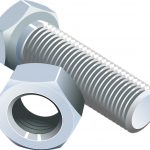 Fasteners threads are made by one of two processes. Rolling the threads of the bolt or cutting them. This newsletter will describe each process, as well as the advantages and disadvantages.
Fasteners threads are made by one of two processes. Rolling the threads of the bolt or cutting them. This newsletter will describe each process, as well as the advantages and disadvantages.
Rolled Threads
This type of thread is made by a forming process where threads are created as the fastener material passes through a hardened set of metal dies at high pressures. The dies penetrate the smooth, thread-less material creating a finished thread with perfectly formed thread roots and crests behind. H
Advantages
• More economical process as they are less labor intensive.
• By deforming and cold working the bolt in the rolling process the bolt becomes stronger (without tears and cracks of a cut thread) – hence more resilient.
• Rolled threads are smoother.
Cut Threads
A cut thread is made by actually cutting or machining into the round bar and removing material from the bulk piece to create the roots and peaks of the threads.
Disadvantages
• Cutting leaves behind tiny tears in the threads which can spread over time and compromise stability and longevity of the thread.
Advantages
• Can meet almost all specifications.
• Bolts can be manufactured to more specific size and dimensional requirements with few limitations regarding their diameter and thread length.
• Can create bolts at much higher diameters than the rolled thread process.
• Simple setup is ideal for small batch runs
Rolled vs Cut Threads
This entry was posted in Application, Blog, Material, Specialty Metal Fasteners and tagged Bolt Cut Threads, Bolt Rolled Threads, Bolts Cut Threads, Bolts Rolled Threads, Cut Thread Bolt, Cut Thread Bolts, Cut Thread Fastener, Cut thread Fasteners, Cut Thread Screw, Cut Thread Screws, Cut Threads, Rolled Thread Bolt, Rolled Thread Bolts, Rolled Thread Fastener, Rolled Thread Fasteners, Rolled Thread Screw, Rolled Thread Screws, Rolled Threads, Screw Cut Threads, Screw Rolled Threads, Screws Cut Threads, Screws Rolled Threads. Bookmark the permalink.
Not sure what material is best for your application?
Contact an Expert
